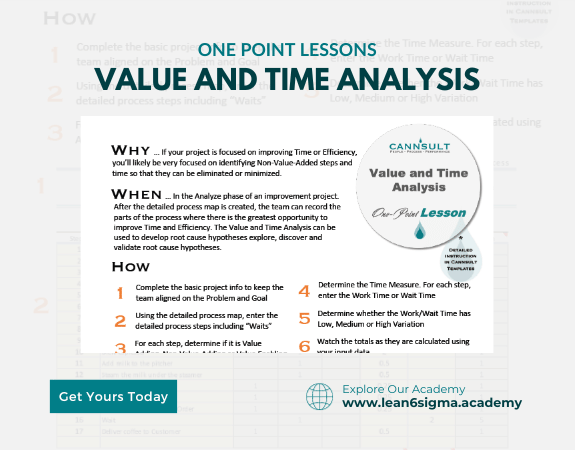Time & Value Analysis
Improve Efficiencies
Enhanced Customer experience
Identify your Wsates
Teamwork!
Problem solving champion!
Value and Time Analysis is a method used to identify and eliminate waste by distinguishing between value-added and non-value-added activities in a process.
Description:
Value and Time Analysis is a Lean methodology tool that helps organizations pinpoint waste within their processes. By distinguishing between value-added and non-value-added activities, you can prioritize improvements to enhance efficiency and reduce waste.
Steps:
Select the Process: Choose a specific process you want to analyze. Ensure that the process is well-understood and has clear goals.
Define Value: Determine what the customer values or is willing to pay for in the process. Value is anything that directly contributes to meeting customer needs or expectations.
Identify Value-Added (VA) Activities: List all the activities within the process. Identify which activities directly contribute to creating value for the customer. Label these activities as "Value-Added."
Identify Non-Value-Added (NVA) Activities: Identify activities that do not directly contribute to value creation. These are often considered waste. Label them as "Non-Value-Added."
Classify Non-Value-Added Activities: Within the Non-Value-Added category, classify activities into the 8 Wastes categories (e.g., Transportation, Inventory, Motion, Waiting, Overproduction, Overprocessing, Defects, Underutilized Talent).
Measure Time: For each activity, measure the time it takes to complete. This is often referred to as "cycle time."
Calculate Ratios: Calculate the ratio of Value-Added Time to Total Cycle Time. This provides the Value-Added Ratio.
Calculate the ratio of Non-Value-Added Time to Total Cycle Time. This provides the Non-Value-Added Ratio.
Analyze the Ratios: A high Value-Added Ratio indicates an efficient process with minimal waste.
A high Non-Value-Added Ratio highlights areas where waste is prevalent and improvements are needed.
Prioritize Improvements: Focus on reducing or eliminating waste by targeting Non-Value-Added activities with the highest impact on the process.
Implement and Monitor Changes: Implement process improvements and monitor the impact on the Value-Added and Non-Value-Added ratios. Adjust as necessary.
Benefits:
Identification of waste sources
Focus on value-adding activities
Improved efficiency and productivity
Enhanced customer satisfaction
Key Takeaway:
Value and Time Analysis is a powerful method for distinguishing between value-added and non-value-added activities in a process. By prioritizing improvements in non-value-added areas, organizations can eliminate waste and enhance overall process efficiency.

0 Reviews
Riaan is a dynamic leader, coach, facilitator, Lean Six Sigma Master Black Belt with over 20 years of hands-on experience driving business results. Riaan is highly skilled and has worked across diverse industries internationally. With a degree in Chemical Engineering, Riaan started in the major breweries and bakeries in South Africa and was so dedicated to his work that he was often known to take his work home with him.
